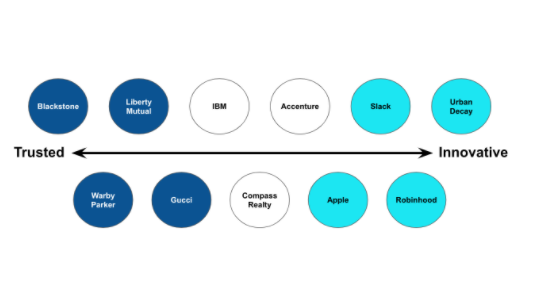 The following is a guest post on brand positioning from Grant Polachek, head of Branding at Squadhelp.com, the world’s #1 naming and branding platform.
The following is a guest post on brand positioning from Grant Polachek, head of Branding at Squadhelp.com, the world’s #1 naming and branding platform.
Every year, the number of startups flooding the US keeps growing. And one thing common about startups trapped in this flood is that they lack a guiding principle that’ll help them identify their position in the market.
This issue was worsened when customer trends and supply chains shifted radically in response to the COVID pandemic.
And the only solution that’ll help brands tackle the uncertainty in the market is understanding brand positioning principles.
In a survey, we recently put some of these principles to the test to see how different customers react to modern vs. classic brand positioning.
The Purpose of the Survey
Our purpose was to discover what particular brands customers were drawn to and how that varies depending on the audience demographics.
This understanding would help you make quick branding decisions, whether you run a small, medium, or large company, and choose a position that fits your business.
And to achieve our purpose, we asked people living in the US, ‘Would you prefer to work with a modern and innovative company or a historied and trusted organization?’
Why this Question?

Courtesy: Unsplash
Understand that one of the most important and defining decisions you’d have to make when building your business or rebuilding your brand is choosing the tone of your business. This decision is critical because it’d help business owners, product managers, and brand leaders shape the future of their business.
Imagine if:
- Steve Jobs didn’t pick Apple as his company’s name
- Zappos still bore the name ShoeStore
- Hydrox chose an exciting name
Your brand’s tone shapes the general attitude of your business and the feelings customers would associate with your brand. Your tone is so vital that you must include them in your naming strategy for your business.
Even though there are many brand tones, most of them tend to lie between the two extremes of the spectrum: ‘historied and trusted’ tones or ‘modern and innovative’ tones.
Take a look at some historied brands:
- Gucci
- Warby Parker
- IBM
- Liberty Mutual
Here’s a look at some modern and innovative brands:
- Slack
- Apple
- Robinhood
- Urban Decay

Courtesy: Squadhelp
When it comes to picking a brand position, the most important issue is: Do you want a creative, modern, and cutting edge brand, or a classic, trusted, and timeless one?
This question is critical to business owners and brand managers, so we carefully designed our survey to determine which members of the audience are attracted to modern businesses and which are attracted to trusted brands.
This would help you understand what your target customers are attracted to.
Here’s the Result of the Survey
Although the results of the survey were expected in some ways, they were definitive in others. Here’s a breakdown of the answers from our 301 participants:
- Young people between the ages of 25–34 have a stronger preference for modern and innovative brands. Just over half of the participants picked new and innovative over historied and trusted.
- 35–45-year-olds chose new and innovative brands, although this group was evenly split between the two alternatives.
- People between 45–54 and 55–65-years-old were more interested in trusted companies with a long history.
- People between 55–65-years-old were most drawn to historied and trusted brands. Nearly twice as many participants selected this choice.
- Men were shown to have little to no preference in choosing either a modern brand or a trusted one.
- Women were more likely to select historied and trusted brands. Slightly less than 60% of the female participants chose this.
- Overall, of the 301 participants, 153 persons chose historied and trusted brands, while 148 chose modern and innovative brands. This shows that either option is great; it all depends on your target audience.

Courtesy: Squadhelp
Here’s What it All Means
According to the findings of our survey, lots of young people are interested in new and innovative businesses. So if your target customers are Gen Z, Millennials, or younger Gen X, then consider properly positioning your business by giving it a modern and unique brand identity.
But, if you’re attempting to reach an older customer demographic, such as older Gen Xers and Baby Boomers, you’ll need to go the conventional route and position your firm with a classic brand name, since individuals between the ages of 45 and 65 have a strong affinity for traditional and trustworthy brands.
The survey clearly shows why it’s necessary for entrepreneurs to properly analyse their brand’s tone before positioning or naming their business. And when it comes to naming, one of the best ways of getting a powerful brand name is by using a business name generator.
The position of your organization is critical in defining how your target audience perceives you.
How this Works in the Real World?
A great example of this in real life would be Hulu. A name that when it launched tilted the sliding scale of brand tone to the extreme for being ‘modern and innovative.’ And considering how well Hulu has performed, with over 40 million subscribers, you know their bets paid off big time.
Now, Hulu’s success stemmed from the fact that the brand’s tone is just perfect for its target customers and the service it provides.
Young people, from millennials to Gen Xers, form the core of their audience and from what we’ve seen earlier, this demographic wants a brand that is ‘fresh and innovative.’
Liked this post about brand positioning? Click here and sign up for the Savvy-Writer newsletter.
